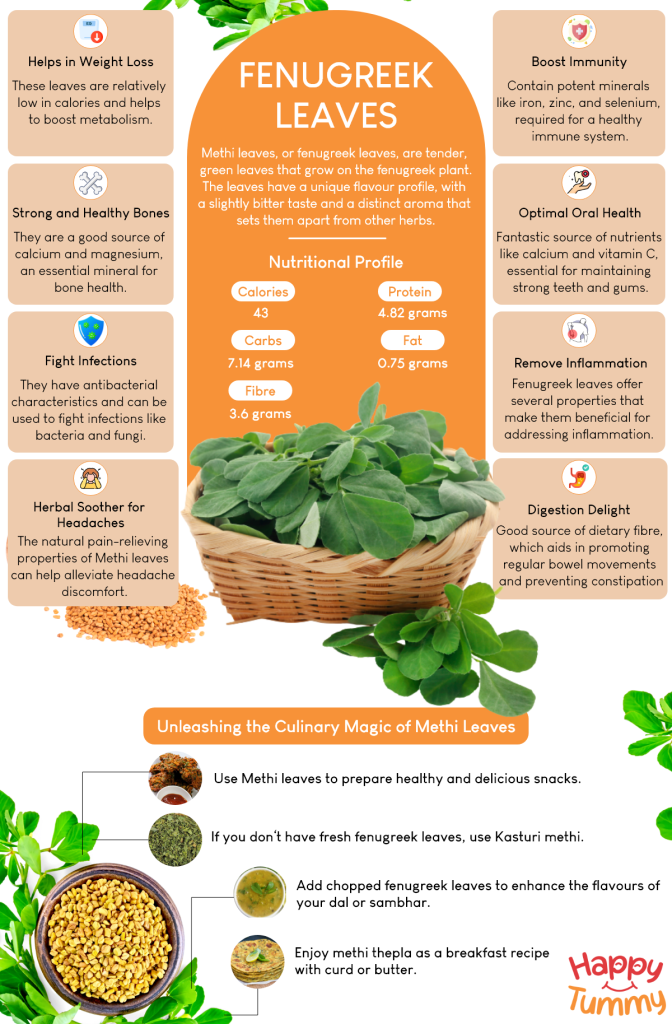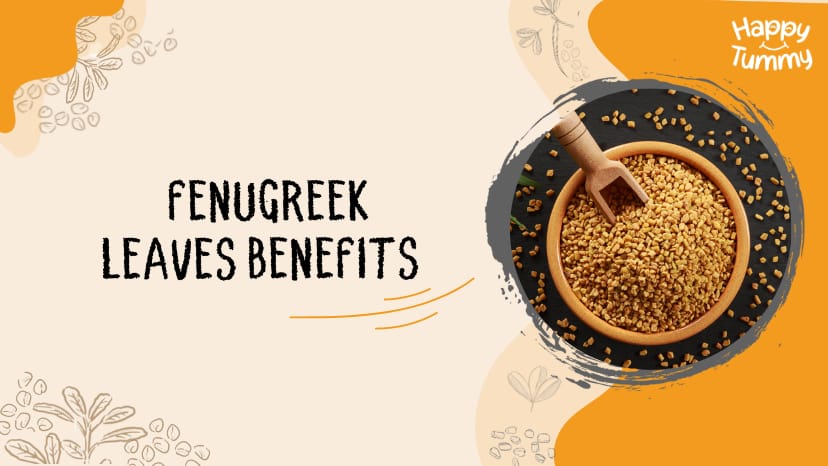Table of Contents
Winter is a season that holds a unique allure and blankets the world in its icy embrace. It creates a captivating atmosphere as the temperature drops and frost glistens on the ground. With winters comes a delightful gift from nature – Fenugreek leaves, also known as Methi.
Methi leaves, bursting with a distinct aroma and a slightly bitter taste, add a unique flavour profile to winter dishes.
So, today, let’s talk about this little herb that packs a big punch – fenugreek leaves!
You may have seen them in Indian curries or sprinkled on top of dishes, but did you know that these fantastic leaves offer a treasure trove of surprising benefits?
From enhancing your cooking to improving your health, fenugreek leaves have much to offer. You can make many dishes from this versatile herb.
Methi becomes an essential ingredient from warming soups to mouthwatering side dishes and delicious parathas, infusing its earthy essence into every bite.
Through this exciting article, let’s uncover the numerous secrets, flavours and hidden potential of methi leaves together.
Get ready to join us on a flavourful adventure that will leave you wondering how you will ever live without the magical fenugreek leaves!
Know Everything about Nature’s Wonderful Herb – Methi!
Methi leaves, or fenugreek leaves, are tender, green leaves that grow on the fenugreek plant. Fenugreek is an annual herb that grows naturally in the Mediterranean region.
Its seeds and leaves are used in cooking. Methi leaves are an essential ingredient used in many Indian dishes. The leaves have a unique flavour profile, with a slightly bitter taste and a distinct aroma that sets them apart from other herbs.
Aashirvaad Multigrain Atta
Whether fresh or dried, methi leaves bring flavour and a touch of exotic flair to countless culinary creations such as methi ki sabzi and especially methi ke parathas. Try cooking methi parathas in Aashirvaad Multigrain Atta to get the complete nutrition your body needs. The atta is rich in fibre with the goodness of six different grains to keep your tummy happy tummy.
Nutritional Profile of Nature’s Nutritional Powerhouse – Fenugreek Leaves/Methi Leaves
Methi leaves boast a remarkable nutritional profile that makes them a superfood. A 100-gram serving of fenugreek leaves provides the following [1]:
| Elements | Amount |
| Calories | 43 |
| Fat | 0.75 grams |
| Carbs | 7.14 grams |
| Protein | 4.82 grams |
| Fibre | 3.6 grams |
A Flavourful Feast of Health Benefits – Methi Leaves/Fenugreek Leaves

Because of their outstanding health advantages, Methi leaves are essential to your kitchen arsenal.
These brilliant green leaves, a wealth of essential vitamins, minerals, and bioactive substances, support overall health in various ways. Let’s look at them in detail:
1. Fenugreek Leaves for Digestion Delight, Keeps Tummy, Happy Tummy
Do you know Fenugreek leaves are a good source of dietary fibre, which aids in promoting regular bowel movements and preventing constipation [2]?
Fibre adds bulk to stool, making it easier to pass through the digestive tract and promoting healthy bowel movements. And if you want to know how much fibre is in that delicious Methi parathas you cooked, check it on My Meal Plan, designed by Aashirvaad Atta with Multigrain.
Just enter the dish you prepared, and voila, in seconds, it will show what is the fibre content in that particular product.
Fenugreek leaves also contain anti-inflammatory compounds that can soothe the lining of the digestive tract.
It might be beneficial for persons who experience digestive issues like acid reflux. It is also well known for its carminative effects, which can aid in reducing gas production and abdominal bloating.
Moreover, the prebiotic properties of Methi leaves may also support a healthy gut microbiome.
Prebiotics are compounds that nourish beneficial gut bacteria, promoting a balanced and thriving gut environment: one herb and so many wonders only to keep your tummy happy tummy.
While checking the My Meal Plan, remember to check the digestive quotient test introduced by Aashirvaad Atta with Multigrain. It will tell you how much you score out of 100 regarding your digestive health.
2. Trim with Taste. Eat Methi Leaves for Weight Loss
Methi leaves are full of magical wonders; you need them if you are on a weight loss journey.
These leaves are relatively low in calories, making them a great addition to your meals without significantly increasing caloric intake [3].
They help you meet your daily calorie goals while offering vital nutrients. Additionally, the dietary fibre in these leaves can help you feel fuller for extended periods and consume fewer calories overall.
If you believe that is it.
Wait, there is more to Methi leaves. Fenugreek leaves contain certain compounds that may help boost metabolism.
A more efficient metabolism can assist in burning calories and promoting weight loss.
It may also help control appetite and curb cravings, reducing the desire to snack between meals and leading to fewer calories.
Aashirvaad Multi Millet Mix
You can make methi oats roti or methi chilla with sprouted moong, which will be perfect weight-loss recipes.
When making this methi oats roti, use Aashirvaad Multi Millet Mix; it has the power of several gluten-free millets and helps in weight loss.
3. Want to Boost Immunity Naturally? Include Methi in Your Diet
It will surely convince you if you have not realised how good eating methi leaves is by now. The potent minerals found in fenugreek leaves boost and strengthen the immune system [4].
They have abundant Vitamin C, an effective antioxidant that protects cells from oxidative cell damage by free radicals and supports the immune system.
The formation of white blood cells, essential for battling infections, is another advantage of vitamin C.
Methi leaves contain vital elements, including iron, zinc, and selenium, required for a healthy immune system.
Iron is necessary for creating haemoglobin, which provides oxygen to immune cells, whilst zinc and selenium increase the activity of immune cells.
Isn’t it great to include these might leave in your diet in some or the other way?
If you want to consume Fenugreek for immunity, choose recipes rich in antioxidants.
For instance, you can make gajar methi sabzi or mix vegetables in palak methi gravy and serve them with rotis or parathas made with Aashirvaad Multigrain Atta.
4. Methi Leaves/Fenugreek Leaves for Strong and Healthy Bones
Gone are when people only knew milk as the best ingredient for healthy bones.
So, if you have kids who make faces when you offer them milk, try offering them something delicious made of methi now [5]. Fenugreek leaves are a good source of calcium, an essential mineral for bone health.
Consuming enough calcium, the main component of bones can help stop bone deterioration.
These leaves also contain magnesium, another essential mineral for bone health. Magnesium works in synergy with calcium to support bone density and structure.
These leaves also have vitamin K, which is necessary for the metabolism of bones. Creating proteins that control the formation and remodelling of bones requires vitamin K.
Since you will need calcium for bones, including recipes rich in the same will be advantageous.
Try making methi pakoda kadhi or methi and moong sprouts wrap.
5. Methi Leaves/Fenugreek Leaves, Your Secret to Optimal Oral Health
I am sure no one would have thought eating Fenugreek leaves could help them with good oral health [6]. That is what we told you about sharing surprise health benefits.
Methi leaves contain natural antibacterial compounds that can help fight harmful bacteria in the mouth. These properties can reduce the risk of plaque formation, which is a leading cause of tooth decay and gum disease.
This antibacterial property also helps combat bad breath. Fenugreek leaves reduce the germs in the mouth that create foul breath, improving breath odour.
These leaves are a fantastic source of nutrients like calcium and vitamin C, essential for maintaining strong teeth and gums.
Calcium keeps teeth durable and strong, and vitamin C promotes collagen growth in the gums.
Do you want to know the best way of using Methi leaves? Use them as a natural mouthwash.
Boil one portion of Methi leaves with two parts of water. Let it reduce, cool down, and your natural mouthwash is ready.
6. Methi Leaves Your Superhero for Fighting Infections
These leaves help battle bacterial, viral, or fungal diseases, just as you should eat them for immunity [7].
Flavonoids and alkaloids found in fenugreek leaves have antibacterial characteristics and can be used to fight infections like bacteria and fungi. These leaves have a well-known beneficial effect on respiratory health.
They may help relieve symptoms of respiratory infections, such as coughs and congestion.
In the past, Methi leaves have been used to address skin infections due to their antimicrobial and anti-inflammatory effects.
These leaves were also used as a paste to address skin infections or wound healing. Although, you should prefer to consult a doctor in case of any wound.
7. Methi Leaves, A Natural Way to Remove Inflammation
Fenugreek leaves offer several properties that make them beneficial for addressing inflammation [8].
For instance, methi leaves have anti-inflammatory qualities due to bioactive substances such as flavonoids, alkaloids, and saponins.
These substances can lessen inflammation and ease the pain brought on by inflammatory disorders.
These leaves can also support joint pains, all thanks to their anti-inflammatory effects.
You can even use Methi leaves to address inflammation and soothe conditions like eczema or acne.
8. Methi Leaves/Fenugreek Leaves, Your Herbal Soother for Headaches
Who doesn’t have a headache problem some or the other time? It is becoming a common issue, and if you have a herbal and natural way to combat it, then nothing like that [9].
The natural pain-relieving properties of Methi leaves can help alleviate headache discomfort.
These leaves are believed to have calming effects, which may help reduce tension and stress-related headaches.
In addition, these leaves are hydrating, and staying hydrated can play a role in preventing or managing headaches.
Also read – Benefits of Fenugreek Seeds
Unleashing the Culinary Magic of Methi Leaves/Fenugreek Leaves
Discovering the wonders of fenugreek leaves in your kitchen is like finding a treasure chest filled with delightful culinary possibilities.
These vibrant green leaves can elevate the flavours of your dishes to new heights, leaving your taste buds longing for more. There are various ways to unleash the magic of fenugreek leaves in your cooking.
Let’s look at some of them:
- Use Methi leaves to prepare healthy and delicious snacks. You can make bajra methi khakhras, methi tikki, methi dhokla, and methi muthias. You can serve these with tea and coffee.
- A lot of delicious side dishes or sabzis can be made using this versatile vegetable. If you have yet to try, make Methi chi patal bhaji, paneer methi chaman, or methi malai mutter. Serve these with rice, roti, or parathas of your choice.
- Add chopped fenugreek leaves to enhance the flavours of your dal or sambhar.
- Enjoy methi thepla as a breakfast recipe with curd or butter.
- If your family loves rice, you should make methi corn pulao. It will be different from the regular pulao, and all will love it.
- If you don’t have fresh fenugreek leaves, use Kasturi methi. It can be added as a spice in various veg and non-veg dishes, and even tea.
Fenugreek Leaves: Beyond the Kitchen Magic
Methi leaves have extended their influence far beyond the confines of the kitchen.
With their remarkable health and beauty benefits, these vibrant green leaves are embraced in various applications. Here are some of them:
- You can make a face mask made of Methi leaves or seeds.
- A paste made of methi leaves can be used on hair to solve dandruff and hair fall issues.
Rewinding Our Knowledge of Methi Leaves/Fenugreek Leaves
In conclusion, Fenugreek leaves genuinely deserve their place as a culinary gem, holding many surprises and health benefits.
From their aromatic charm in the kitchen to their potential to enhance immunity, aid digestion, support bone health, and so much more, these vibrant green leaves have proven to be a treasure trove of goodness.
So, let your culinary creativity run wild and explore the boundless possibilities of Methi leaves in your dishes.
Embrace the delightful flavours and nourishing properties they offer, and savour each bite, knowing that you’re not only delighting your taste buds but also nourishing your body with nature’s remarkable gift.
Unleash the power of these leaves, and embark on a journey of flavourful experiences and a healthier, happier you!
FAQs
There is a reason why Methi leaves are known as nature’s true gift. These leaves have anti-inflammatory properties that support health in many ways. Alongside, it is an excellent ingredient for gut health and weight loss.
Fenugreek leaves can be eaten raw, but it should be noted that they have a mildly bitter flavour that may only appeal to some people. While some people appreciate the bitterness, others prefer to cook with the leaves so the bitterness can soften out and create a distinctive flavour.
The fenugreek plant yields methi leaves and has been cultivated and used for thousands of years. It was used in cooking and healing for a long time in antiquity, especially in Egypt.
Most people can use fenugreek leaves in moderation as part of a healthy diet.
There is no one way of using methi leaves, which can be added per one’s preference and taste. For instance, you can add these leaves in curries, side dishes, parathas, rice, salads, theplas, dal, and chutney, or use them as Kasturi methi.















